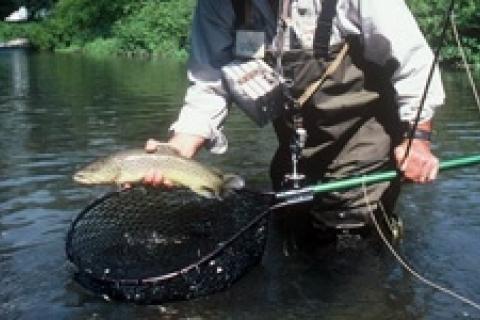
 I've been blessed to fish for trout with dry flies on some of the top waters in the country, from the Bow River in Alberta to the Big Horn in Montana, from the Beaverkill in New York to the Hiwassee in Tennessee. Over those decades of angling, several hatches have stood out for providing spectacular fishing. A while back we looked at one of those — the Blue Winged Olive. Here's another that fits into that category of superstar hatches — the Tiny Black and White, or Trico hatch.
I've been blessed to fish for trout with dry flies on some of the top waters in the country, from the Bow River in Alberta to the Big Horn in Montana, from the Beaverkill in New York to the Hiwassee in Tennessee. Over those decades of angling, several hatches have stood out for providing spectacular fishing. A while back we looked at one of those — the Blue Winged Olive. Here's another that fits into that category of superstar hatches — the Tiny Black and White, or Trico hatch.
Even though it's a mouthful to say, most ardent trout fishermen call this by its full Latin name — Tricorythodes. Few other emergencies can match the intensity or reliability of this tiny black and white mayfly for summer fly fishing sport. Millions of the duns emerge early in the day, followed by stunning spinner flights at mid-morning.
But while the fishing can be fantastic, it is also immensely challenging. The reason for the difficulty is a combination of the tiny size of the insect and the abundance of naturals on the water. This latter fact makes it less likely the trout will key in on your imitation floating amid thousands of real bugs.
The Trico measures a mere 3-4 millimeters. Size 22-26 hooks are appropriate. This makes it tough for you to see the fly and difficult to hook fish when they sip in your offering, because of so little gap in the hook.
But the intensity of the trout's feeding on these insects makes up for those challenges by giving you plenty of chances. Fish literally slurp the flies in non-stop for hours throughout the morning. If a trout strikes and you miss it, simply recast to another one.
Be sure to study the rhythm of the fish's feeding pattern. You want your fly to drift over the trout just as it's ready to rise. Use a 3 to 5 weight rod, 12-15 foot leader and 6x or 7x tippet.
For duns a parachute or Thorax tie is best. Most of the action will center on spinner fishing as the mating insects swarm over the water with their tiny glassine wings sparkling in the morning sunlight. First the dark males gather in tight clusters. Then the females join them and the dance of life ensues. Riffles and pools directly below them are particularly good areas.
A rabbit or mole fur body with split hackle tails and polypropylene spent wings is the best pattern. Males have all-black bodies. Females have a black thorax and whitish abdomen.
For those of us with declining eyesight, seeing these flies on the water can be difficult. Try painting a bright fluorescent orange dot on the top or tying in a tiny piece of bright orange polypropylene on top where the fish can't see it but you can.
If hooking fish is a problem, try using the multiple-fly. Trout sometimes grab two or three Tricos at once. In certain cases you can have success using a size 16 or 18 hook with two or three sets of bodies and wings tied on the shank, to simulate a cluster of flies floating down in a wad.
- 2288 views

